New York Central Park is the largest in the United States and the most famous in the world. It is located in Manhattan. The park is rectangular in shape – about 4 km long and about 0.8 km wide, its area is about 3.5 sq. km. It is visited annually by about 25 million people and has been shown in many films and television shows.
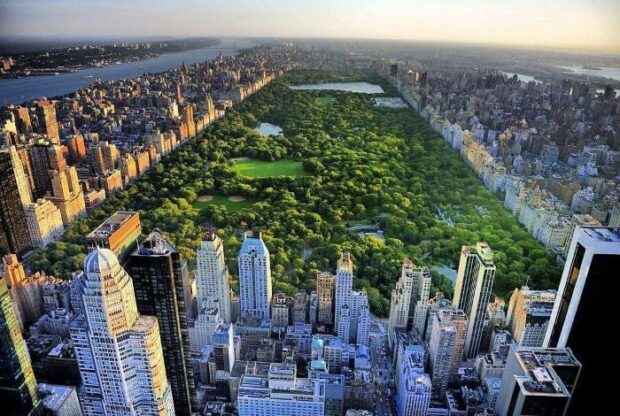
Since 1820, the population of New York City has multiplied over a 30-year period. The city has been rapidly expanded and built, with fewer recreational facilities. Talk has begun of the need for a public recreation area. Many influential New Yorkers wanted a stylish place to go. The Boulogne Forest in Paris and Hyde Park in London were a model. Of course, certain people had a commercial interest in creating such a place.
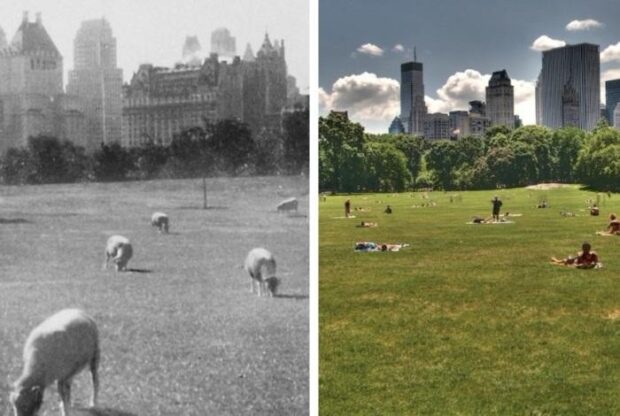
Central Park then and now. Until 1934, part of the park was a grazing area for sheep.
The park was originally intended to be on the East River for six months, but the site was too small. Therefore, the area of the modern park was chosen, which was 5 times larger and rectangular. The area was not suitable for development because of the difficult terrain and rocky ledges. Its location, the centre of the island, and the relatively low value of the land, due to the features of the terrain, were a success.
In the summer of 1853, the legislature of New York decided to establish a park whose territory was private property – it was forcibly expropriated.
More than 1,500 people were legally displaced and all the buildings were demolished – they were mostly single-story structures. There were also schools and churches. This loss was compensated by the owners – it was planned to spend $5 million on it.
In the mid-1950s, New York City went through difficult economic times, so the question arose of reducing or moving the selected site. This stage was overcome. In the spring of 1857, a landscaping competition was announced. There were certain requirements for the future project: to preserve several roads that passed through the park, to organize one front and three playgrounds, a classical garden, a panoramic tower and a pavilion for exhibitions or concerts. Examples of landscaping included Green Wood and Mount Auburn cemeteries, which were buried in green.
The first chief architect of the park was Frederick Olmstead, who, along with Calvert Wox, won a landscaping competition (33 works in total). The project was presented in the spring of 1858. It was a traditional English park, with emphasis on natural naturalism with minimal elements of urban landscape.
READ 11 Best Films Featuring in New York Central Park
Construction of the park began in 1858, and official opening took place in 1873. During this time the soil cover was removed, replacing it with fertile land from New Jersey and Long Island (over 7 million cubic meters)blew up most of the rocks and created a drainage system to ensure optimal humidity. The landscape has changed dramatically. It has become clear that several times more funds will be needed than planned. This led to a change in personnel – management was assigned to Andrew Greene. The park was opened in stages. At first, a rink was available on the lake (1858), then a pond, esplanade and alleys with arched bridges (1860).
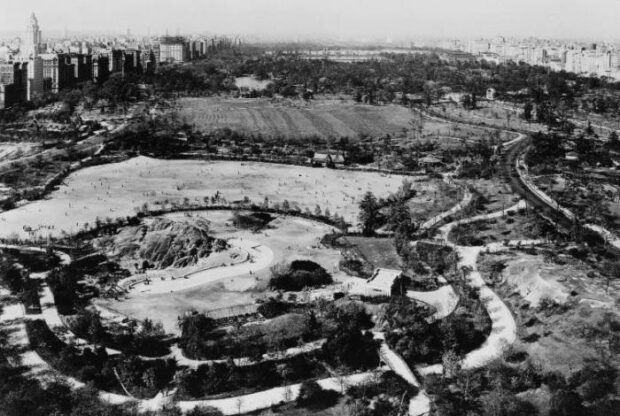
The park was enlarged (1863), but construction stopped due to the civil war. After it many architectural structures were built: Belvedere Castle, Ice Cream Pavilion, Mineral Water Pavilion, Bethesda Fountain, Carousel. By 1865, the park had been visited by up to 7 million people annually.
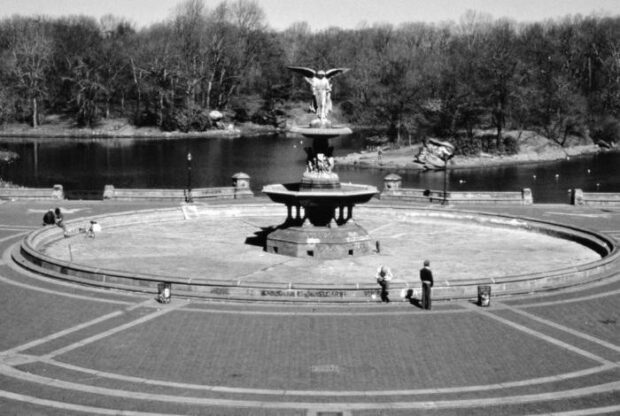
Bethesda fountain, 80s
The park was different from the original plan. They made separate disjoint paths (pedestrian, recreational, horseback riding), increased the number of bridges (34 instead of 9), each of which is unique in its architecture.
At first, only wealthy people visited Central Park. They had free time and the opportunity to ride in horse-drawn carriages. During the weekend, the park came alive – some visitors came on foot. They enjoyed nature, went on boat rides, ice skates. Initially, the zoo was not planned in Central Park, so it was organized in a spontaneous way. Animals were donated to the park by city residents.
READ Top 30 Central Park Facts Worth Exploring
At first the pens were equipped near the esplanade, but then the zoo expanded and was moved to the Arsenal building. The Central Park Zoo became an official establishment in 1870. At the same time a new move took place – the premises were equipped behind the Arsenal and the building housed the Natural History Museum.
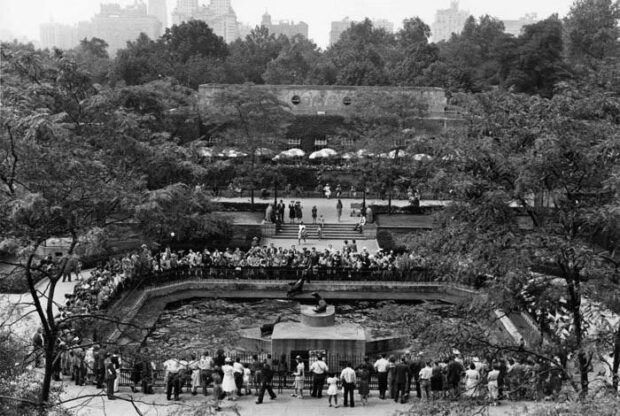
Zoo in Central Park, 19th century.
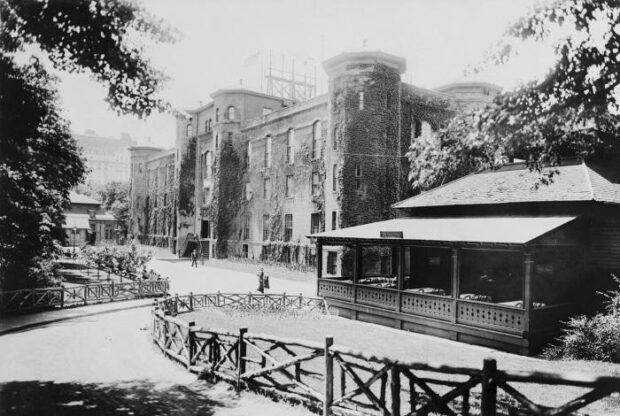
Arsenal building
In the 1980s, the park became more popular and its cultural program became more diverse. On weekends, we used to ride boats, ponies, goat carts. Commercial stalls were allowed, concerts were organized, and lawns became available for sport.
In 1912, gravel was replaced by asphalt on park lanes. New team games were allowed on the lawns. In 1926, the first playground was opened, which is still the largest in the park.
Almost immediately after completion, the park began to wither, partly due to inadequate funding. It was not until 1934 that reconstruction began, led by Robert Moses. Bridges and alleys were repaired, sports and playgrounds were built, lawns were planted and a new zoo was established.
READ Visiting New York’s Central Park: 10 Top Attractions
Moses had a new look at the organization of the park – he understood that some things were obsolete, there was a need to organize active recreation areas and a developed system of health facilities. Before the war, he was able to create a wide lawn, bowling grounds, cricket, and shuffleboard. At the same time a new zoo was created – wooden barracks for animals were replaced by spacious stone buildings.
From the beginning of the 20th century until World War II, the Central Park has changed dramatically. This has affected not only its appearance, but also its cultural side. The park has become a venue for various festivals, carnivals, sports and cultural events.
After World War II, funding was again insufficient, but Moses attracted sponsors, perpetuating their names (Michael Friedsham carousel, Wallman Rink rink rink, Lasker Rink Basin).
Since the 1960s, the park has been a venue for public events. Performances, festivals, concerts and fairs have been organized here. Political events were also held.
The city’s administration encouraged various activities in the park, which negatively affected it. There were informal parties, marijuana sales, loud music. The park became dangerous at night, its attractions were covered with graffiti, water bodies littered and lawns covered. Combined with the crisis of the 1970s, this led to the poor state of Central Park.
Like us on Facebook for more stories like this: